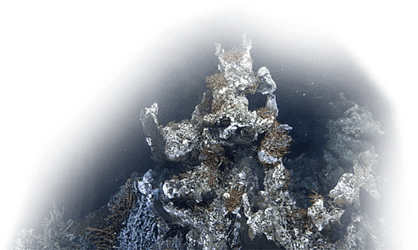Information in this story has been updated to reflect subsequent lab study and analysis.
On 15 May, onboard the E/V Nautilus, the remotely operated (ROV), Hercules, dove to Barkley Canyon’s mid-canyon location, where a seafloor camera monitors benthic communities 24/7. With the successful repair, re-deployment and re-connection of the Barkley Node and extension cables earlier this month, we are now able to continue long-term monitoring of seafloor communities and experiments in Barkley Canyon. At this site enrichment and perturbation experiments that began in 2013, examine these unique biological systems, change under varying oceanographic conditions.
Map of Ocean Networks Canada's installations in Barkley Canyon off the west coast of Vancouver Island. This site is part of the NEPTUNE observatory.
During this dive we were able to successfully inspect and recover a whalebone experiment that was deployed two years ago, from the CCGS Tully. The experiment includes three packages: one contained three rib sections of a humpback whale (stranded in Alaska several years back); another contained a block of Douglas Fir; and a third contained a large piece of carbonate collected from a methane seep located off the coast of California.
These experiments are designed to study deep sea community succession, colonization and bacterial decomposition processes on the seabed. Ocean Networks Canada’s seafloor observatory makes it possible for scientists to study deep-sea ecosystem responses to perturbations at an extremely detailed time resolution. This experiment monitored the precise rates of microbial colonization (see animated gif below).
Time-lapse video of bacterial mat growth on whalebones (from day 3 to 244, 8 months of experiment). The experiment is a collaboration with Dr. Craig Smith, University of Hawaii; Dr. Lisa Levin, Scripps Institute of Oceanography; and Dr. Jacopo Aguzzi, the Institute de Ciencies desl Mar in Barcelona.
The greyish black colored mats result from the aerobic bacteria breakdown of sulfide produced by anaerobic bacteria degrading bone lipids within the bone matrix. The release of sulfide by anaerobic bacteria also facilitates the colonization by specialist bone fauna such as the siboglinid polychaetes from the genus Osedax (Greek for ‘bone devour’). Of particular interest is how the bone colonization process by Osedax takes place in a low oxygen environment such as in Barkley Canyon. At water depths of 1000 m, Barkley Canyon’s oxygen minimum zone has a direct effect on benthic organisms, often reducing community abundance and diversity.
During the dive to this site, a thorough video inspection of the experiments was completed using Hercules HD video camera. The plan was to recover the largest whalebone for laboratory analysis, leaving two bones behind for continuing observations.
ROV Hercules clipping the cable ties securing the whalebone to the experiment package.
With surgical precision, the Hercules pilot clipped three cable ties in a maneuver that took less than 5 minutes to complete. The whalebone was then brought to surface in a sealed biobox located on the ROV’s starboard side, where it was taken to the wet lab for examination.
The science party onboard inspected the sampled whale bone and saw a few crustaceans and small polychaete worms colonizing the bone’s surface. However, no signs of Osedax to their disappointment. There have been 31 different species of Osedax described to date, found on natural whale remains and implanted whalebone experiments from several ocean basins. Due to virtually inexistent studies in this area of the Pacific Ocean, ONC scientists predict that any Osedax species collected from these whale bones in Barkley Canyon may represent a new species to science.
Examples of the bone-eating siboglinid, Osedax recovered from near the West Antarctic Peninsula. Image credit: (A) and (C) T. Dahlgren, (B) C. Smith and D. Honig, (D) N. Higgs. Source: Annu. Rev. Mar. Sci. 2015 7:571-96 Whale-Fall Ecosystems: Recent Insights into Ecology, Paleoecology, and Evolution Smith et al.
